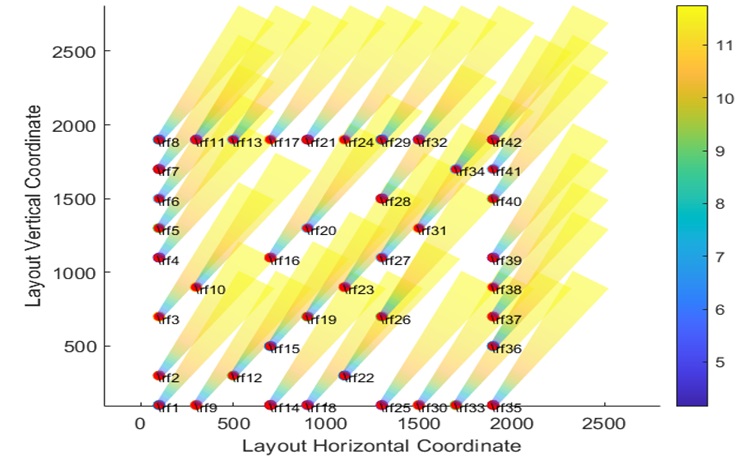Optimization of the Offshore Wind Turbines Layout Using Cuckoo Search Algorithm
DOI:
https://doi.org/10.51173/jt.v6i2.2585Keywords:
Cuckoo Search Algorithm, Renewable Energy, Wake Effect, Wind Farm, Wind TurbineAbstract
Wind turbines have gained popularity as one of the efficient micro grid energy generation sources over the years. However, wind energy yield has been greatly impacted by the wind farm wake effect, especially when the size of the wind farm becomes very large. One way to address this challenge is through wind turbine arrangements and their scalability. Developing effective means of optimizing wind farm configurations is a major concern for energy communities. This has continuously led to increased power generation and a corresponding cost reduction. As such, this research article developed an optimal large-scale offshore wind turbine placement based on wind farm layout design. The system developed focuses on wind turbine placement in wind farm layouts that have a negative influence on the capital investment due to the increasing wake effect thereby reducing energy production. A multi-objective function consisting of wake effect and component costs within the wind farm is formulated. After-which a cuckoo search algorithm technique is employed in the wind farm model to optimize the optimization problem (minimizing the wake effect while improving power output and cost). Four test case scenarios were considered when implementing the wind model. The results obtained from the developed scheme were compared with those obtained when other optimization techniques were used, using power output and cost as performance metrics. The obtained power output and cost for the test case scenario in the ideal wind turbine position on the wind farm are 18288.3KW, 19680.1KW, 18879.9KW, 21105.8KW and 26.9, 28.7, 26.9, and 29.8KW, respectively. This shows that the result obtained from the developed scheme outperformed that obtained from PSO and that of WOA.
Downloads
References
A. Hafis, A. S. Adamu, Y. Jibril, and I. Abdulwahab, "An Optimal Sizing of Small Hydro/PV/Diesel Generator Hybrid System for Sustainable Power Generation," Journal of Engineering Science Technology Review, vol. 16, no. 6, 2023, doi:10.25103/jestr.166.01.
I. Baba, Y. Jibril, B. Jimoh, I. Abdulwahab, and A. Olaniyan, "Development of Generalised Integrator with a Feedback Loop Based Dynamic Voltage Restorer for Fast Mitigation of Voltage Sag/Swell," Covenant Journal Of Engineering Technology, vol. 7, no. 2, 2023.
I. Abdulwahab, S. Faskari, T. Belgore, and T. Babaita, "An improved hybrid micro-grid load frequency control scheme for an autonomous system," Fuoye Journal of Engineering Technology, vol. 6, no. 4, pp. 369-374, 2021, http://dx.doi.org/10.46792/fuoyejet.v6i4.698.
Raghad Hameed Ahmed and Ahmed Said Nouri, “Improvement of the Power System’s Transient Stability Using the Unified Power Flow Controller with Fuzzy Logic Technique”, JT, vol. 5, no. 3, pp. 61–72, Sep. 2023, https://doi.org/10.51173/jt.v5i3.1249.
S. Alahakoon, R. B. Roy, and S. J. Arachchillage, "Optimizing Load Frequency Control in Standalone Marine Microgrids Using Meta-Heuristic Techniques," Energies, vol. 16, no. 13, p. 4846, 2023, https://doi.org/10.3390/en16134846.
S. R. J. A. E. Reddy, "Wind Farm Layout Optimization (WindFLO): An Advanced Framework for Fast Wind Farm Analysis and Optimization," vol. 269, no. 115090, 2020, https://doi.org/10.1016/j.apenergy.2020.115090.
I. A. U. Musa, S. Sarip, A. A. Mas' ud, F. Muhammad-Sukki, S. A. Faskari, and A. T. Mahmud, "Non-Linear Model Predictive Speed Control of Six Phase Squirrel Cage Generator in Wind Energy System," in 2023 IEEE 6th International Conference on Electrical, Electronics and System Engineering (ICEESE), pp. 50-54: IEEE, 2023, https://doi.org/10.1109/ICEESE56169.2023.10278166.
B. Hoen, R. Darlow, R. Haac, J. Rand, and K. Kaliski, "Effects of land-based wind turbine upsizing on community sound levels and power and energy density," Applied Energy, vol. 338, p. 120856, 2023, https://doi.org/10.1016/j.apenergy.2023.120856.
F. Daqaq, R. Ellaia, M. Ouassaid, H. M. Zawbaa, and S. Kamel, "Enhanced chaotic manta ray foraging algorithm for function optimization and optimal wind farm layout problem," IEEE Access, vol. 10, pp. 78345-78369, 2022, https://doi.org/10.1109/ACCESS.2022.3193233.
S. C. Pryor and R. J. Barthelmie, "Wind shadows impact planning of large offshore wind farms," Applied Energy, vol. 359, p. 122755, 2024, https://doi.org/10.1016/j.apenergy.2024.122755.
P. Taylor, H. Yue, D. Campos‐Gaona, O. Anaya‐Lara, and C. Jia, "Turbine layout optimisation for large‐scale offshore wind farms–A grid‐based method," IET Renewable Power Generation, vol. 15, no. 16, pp. 3806-3822, 2021, https://doi.org/10.1049/rpg2.12295.
T. Kunakote et al., "Comparative performance of twelve metaheuristics for wind farm layout optimisation," Archives of Computational Methods in Engineering, vol 29, pp. 717–730, 2022, https://doi.org/10.1007/s11831-021-09586-7.
A. P. Velenturf, "A framework and baseline for the integration of a sustainable circular economy in offshore wind," Energies, vol. 14, no. 17, p. 5540, 2021, https://doi.org/10.3390/en14175540.
A. C. Pillai, J. Chick, L. Johanning, and M. Khorasanchi, "Offshore wind farm layout optimization using particle swarm optimization," Journal of Ocean Engineering Marine Energy vol. 4, pp. 73-88, 2018, https://doi.org/10.1007/s40722-018-0108-z.
K. N. Pujari, S. S. Miriyala, and K. Mitra, "Jensen-ANN: A Machine Learning adaptation of Jensen Wake Model," IFAC-PapersOnLine, vol. 56, no. 2, pp. 4651-4656, 2023, https://doi.org/10.1016/j.ifacol.2023.10.979.

Downloads
Published
How to Cite
Issue
Section
License
Copyright (c) 2024 Ibrahim Abdulwahab, Solomon Andrew Onazi, Gideon Rimamfate, Akande Abdulwasiu, Abubakar Umar, N.A Iliyasu

This work is licensed under a Creative Commons Attribution 4.0 International License.
















